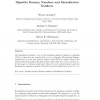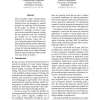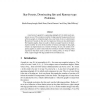57 search results - page 3 / 12 » Edge cover by bipartite subgraphs |
97
Voted
DM
2000
15 years 5 days ago
2000
The Zarankiewicz number z(s, m) is the maximum number of edges in a subgraph of K(s, s) that does not contain K(m, m) as a subgraph. The bipartite Ramsey number b(m, n) is the lea...
ACL
2006
15 years 1 months ago
2006
Given a parallel corpus, semantic projection attempts to transfer semantic role annotations from one language to another, typically by exploiting word alignments. In this paper, w...
115
Voted
AAAI
2012
13 years 2 months ago
2012
In cooperative games, a key question is to find a division of payoffs to coalition members in a fair manner. Nucleolus is one of such solution concepts that provides a stable sol...
109
Voted
SIROCCO
2001
15 years 1 months ago
2001
This paper considers the design of a survivable WDM network based on covering the initial network with sub-networks, which are protected independently from each other. We focus on...
108
Voted
DM
2002
15 years 5 days ago
2002
A star forest of a graph G is a spanning subgraph of G in which each component is a star. The minimum number of edges required to guarantee that an arbitrary graph, or a bipartite...



